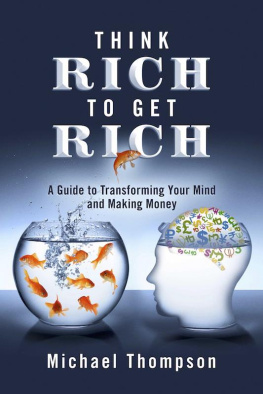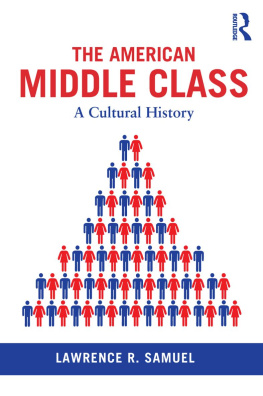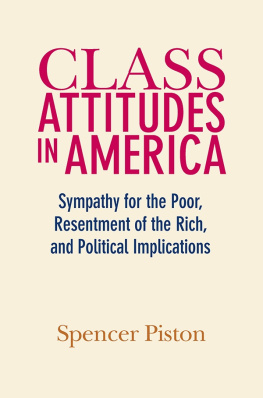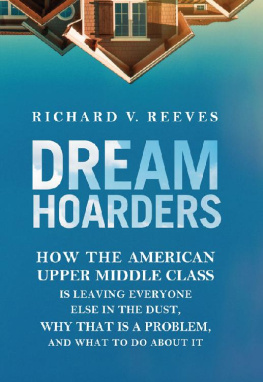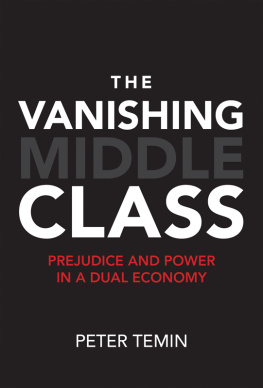
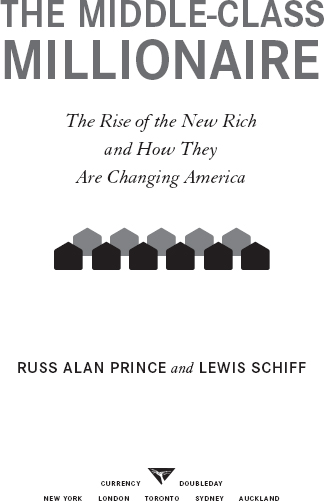
CONTENTS
To Sandi, of course
Russ Alan Prince
To Lynette and Jacob, my network
Lewis Schiff
ACKNOWLEDGMENTS
The idea for The Middle-Class Millionaire occurred on April 22, 2005, during a lunchtime conversation between the two of us at one of New York Citys finest restaurants, Per Se. We were the hired help that day, having spent the late morning in the private dining wing presenting data about recent changes in the financial industry to a room full of financial trade reporters. As the tables were being cleared, Russ and I drifted into a conversation about upcoming research projects. Russ, who is able to see stories, hopes, and dreams in a spreadsheet full of numbers, mentioned his recent discovery of a new demographic of millionaires. (This discovery process is described in the first chapter of this book.) He called them middle-class millionaires. I was immediately struck by that contradiction in termsas many others have been since. Having a million dollars sounds like a fantasy, conjuring up images of first-class status, luxury living, and perhaps most important, financial peace of mind. But for those working Americans whove reached the million-dollar mark and still find themselves with mortgage payments, tuition bills, and other expenses, it can be just a numberand not necessarily an address on Easy Street.
This book doesnt dwell on the financial contradictions of the world we live inalthough thats a worthy topic. Rather, we set out to introduce you to the people who are at the heart of that contradictionthe substantial and increasing population of people who would call themselves middle-class but whose wealth, behavior, and attitudes have put them in a class all their own. Taking the exercise a step further, weve attempted to identify their unique attributes and contributions and explored how these can be harnessed by society at large as well as by the reader for personal and professional gain.
Spending the last two years analyzing a nascent demographic sometimes felt like a risky pursuit. What if, we worried, the Middle-Class Millionaire was really just a new coat of paint on an old cara baby boomer in Burberry? We might have given in to these concerns, denying us the chance to learn about this important and influential body of people, had it not been for certain influential individuals in our lives who encouraged us to move forward. That list begins with our spouses, who, partly because we thought it was worthwhile, found it worthwhile, too. Sandi and Lynette provided more support and guidance than we deserve, and we are grateful for their patience, their love, and their willingness to discuss the topic of this book from nearly every conceivable perspective.
Mark Ganem provided a great deal of guidance that helped turn a vague notion into a fully fleshed-out concept. Mark was extremely generous with his time and extensive experience even before we had an inkling that there was something worth pursuing. And he continued to deliver good advice all the way to the last page. That kind of help is only offered out of friendship and deserves special recognition.
After we wrote an outline, it was time to sell it. The first hurdle was our savvy and knowledgeable literary agent, Robert Levine. Bob liked what he saw but asked us to hone the concept, guiding us through no fewer than ten drafts before finally declaring it ready for market. Again, spouses proved to be essential business partners as Bobs wife, Suzanne Braun Levine, the author of Inventing the Rest of Our Lives: Women in Second Adulthood and a legendary magazine editor in her own right, added her own two cents at a pivotal juncture.
Eventually, the committed editors and staff at Random Houses Doubleday Books, including Stephen Rubin, Roger Scholl, Talia Krohn, Meredith McGinnis, Louise Quayle, and Carolyn Pilkington, saw something they liked and convinced us that the book had an even bigger mission than we originally imagined. They thought that what we were writing about would be valuable to people everywhere who are curious about the world they live in. For opening up a wider set of possibilities, we thank the team at Doubleday Books.
The original research that makes up the skeleton of this story required a survey of 3,714 American households. To do this we called upon the efforts of Russs long-time research partner and collaborator, the talented Karen Maru. Many thanks to her and to those surveyed. Our gratitude also goes to the scores of people who sat for one-on-one interviews for the book. Because they shared their stories with us, we were able to add muscle and tissue to our skeleton of data, bringing this story to life.
Early on we found a writing coachafter all, coaches are used by the very best athletes and businesspeople, so why not us? We can string sentences together, but we believed this book would require the very best we had in us. So we asked Noel Weyrich to help bring it out. Noels dedication to this book was more than we could have hoped for, and we are thrilled that he took the journey with us.
If this sounds like a lot of cooks in the kitchen, it wasnt. In fact, each person in our little army, from our spouses to our friends to our long-time associates to our new business partners, has made an invaluable contribution to this effort. Sentence by sentence, idea by idea, there was something important added by every member of the team. Our names may be on the cover, but they deserve much of the credit for helping bring this book to reality.
Lewis Schiff
CHAPTER ONE
THE INFLUENCE OF AFFLUENCE
I n 2004, the sales department at Elite Traveler magazine asked Russ Alan Prince to conduct a marketing survey of its readership. Elite Traveler is likely the most exclusive consumer magazine in the world. The magazine is distributed primarily on private jets, and it covers subjects such as how to book your own private island. Its reader demographics, with an average household income in the seven figures, eclipse those of its nearest competitor by more than sixfold. Russs job, in part, was to measure how much influence the buying habits of these very affluent readers exert on others around them.
In the field of luxury marketing, purchasing decisions of high-networth individuals are assumed to exert a downline influence on people of the same or lesser means. Elite Traveler wanted to know if Russ could document a similar relationship between the purchasing decisions of the people who read Elite Traveler and other people who associate with them.
Russ has been studying the spending and investing habits of high-net-worth individuals for more than twenty years. He knew that carrying out a methodologically sound survey of very wealthy individuals would be a difficult and time-consuming task. To find 203 respondents willing to answer a long series of personal questions posed by a researcher in personal interviews, Prince had to network his way through lists of financial advisors and private jet services who served as go-betweens. Most of the survey subjects either accepted a $500 payment for their cooperation or directed that sum to one of their pet charities.
The survey results provided Elite Traveler with an unwelcome surprise. According to the survey, the buying decisions of very-high-networth individualsthose with wealth in excess of $10 millionexert very little influence on the people around them. Except for certain celebrities, wealthy people who are influential by almost every other measure dont serve as role models when they purchase goods and services. They are not referentially influential. If they buy something for their home or office, they tend not to talk about it very much. In the case of more easily observable purchases, such as clothes, watches, and jewelry, they seldom interact with enough people on a day-to-day basis to exert any significant influence. And when it comes to providers of personal serviceslife coaches, personal trainers, financial advisorsthe very rich can be very secretive. Express too much praise for your coach or trainer, after all, and he or she might get poached by someone else.
Next page

